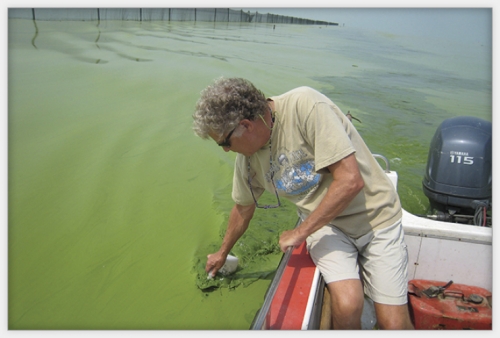Water flowing from kitchen faucets looked like runny split-pea soup. It smelled foul, and no one dared use it, not even to water plants.
It came from Taihu, China’s third largest lake. In June 2007 blue-green algae covered most of the 900-square-mile lake. The government shut down water supplies, including tap water for the four million people in Wuxi city. Chinese officials acted quickly, adding chemicals to try to kill the algae. They scooped out six thousand tons of slime, diverted water from the Yangtze River to flush the lake, and built a plastic barrier to prevent the algae from contaminating the water system again. They also extended the drinking-water intake farther into the lake.
Water color and smell returned to normal after a few weeks, but the blooms persisted until December. Many people refused to drink the tap water, which was understandable, says Carolina marine biologist Hans Paerl. Some blue-green algae, also known as cyanobacteria, produce toxins that can damage the liver, intestines, and nervous system. This hasn’t happened in China, but in 1996 one hundred people fell ill and fifty-five died when toxic blue-greens contaminated the water used at a dialysis clinic in Brazil.
Two weeks after the water crisis, Paerl was leaning over the side of a small motorboat to skim off some of Taihu’s scum for analysis. He discovered that China’s algae belong to the same genus as toxic algae found in North Carolina’s small ponds and stagnant estuaries, as well as in many larger bodies of water, such as Lake Erie, Lake Victoria, and the Baltic Sea. But nowhere are the blooms worse than on Lake Taihu, where habitats for eels, fish, and crabs are becoming endangered. Ten million people depend on a healthy Taihu for drinking water, fisheries, and tourism income.
China can try all kinds of things to kill or contain the algae, but the patient has been chronically ill for a while, Paerl says. Paerl is searching for the cure.
In 2007 Taihu’s massive algae blooms lasted from April to December. In each of the previous ten years, smaller blooms typically lasted from June until October, Paerl says. Before 1980, when the lake was known solely for its beauty, there weren’t any blooms. The lake was surrounded by fields of cotton, grain, tea, fruit, and grass.
Paerl says that Taihu’s problems began when China rapidly industrialized and embraced the market economy without limiting pollution of waterways. Nutrient-rich sewage from wastewater plants and pollution from factories are the main culprits, Paerl says. Also, farmers can now afford fertilizers, which contain nitrogen and phosphorus that find their way into the lake. Blue-green algae thrive on these nutrients, and the result is a split-pea Taihu.
After last year’s water crisis, China’s premier Wen Jiabao called for cleaning up the lake and penalizing polluters. But China will have to do more.
“The first thing they need to do is treat all wastewater for nitrogen and phosphorous,” Paerl says. He estimates that city wastewater treatment plants are responsible for half the nitrogen and phosphorous in the lake. But dealing with the wastewater alone might not stop the bloom. And no one knows how many cutbacks will be needed from farmers and industries. So Paerl and scientists at the Nanjing Institute for Geography and Limnology of the Chinese Academy of Sciences are working together on recommendations based on bioassays of cyanobacteria samples they collected this summer.
New factories spring up each year in the densely populated Jiangsu Province. Shanghai, sixty miles to the east, produces pollution that creates nitrogen-rich acid rain. Taihu is a very shallow lake, and it depends on rainwater for much of its replenishment. “This will be the biggest challenge because it will take a national effort to reduce nitrogen emissions to the air,” Paerl says.
China is promoting eco-friendly development but will soon pump more carbon dioxide into the atmosphere than any other country, warming the atmosphere and boosting blue-green algae growth.
Last April, Paerl published an article in Science showing how algae blooms thrive in warm waters. Part of the warming problem has to do with stratification — when lakes form layers of water with different temperatures. With global warming, Paerl says, lakes are stratifying earlier in the spring and destratifying later in the fall. High temperatures help blue-green algae float to the surface where they absorb sunlight.
“They do very well under high ultraviolet light,” Paerl says. “They can move up and down the water column faster than any other organism because they can change their buoyancy. And they’re like cockroaches; they can survive on very little.”
Some cyanobacteria can fix nitrogen. That is, when they deplete the nitrogen in water, they can suck more nitrogen out of the atmosphere. The dominant blue-greens in Taihu can’t fix nitrogen, but the lake is home to other kinds that can. If China limits nitrogen without limiting phosphorus, other kinds of blue-green algae could dominate, and these could be toxic. This is why Paerl and Chinese scientists are figuring out how much nitrogen and phosphorous should be limited.
“All this has been almost like a lesson in where not to build cities,” Paerl says. “Unfortunately, it’s too late to do anything about that. But it’s not too late for targeting reductions in nitrogen and phosphorous. This is not a doomsday scenario. Not yet.”
Hans Paerl is the William R. Kenan Distinguished Professor in the Institute for Marine Sciences. He received funding from the National Science Foundation.




